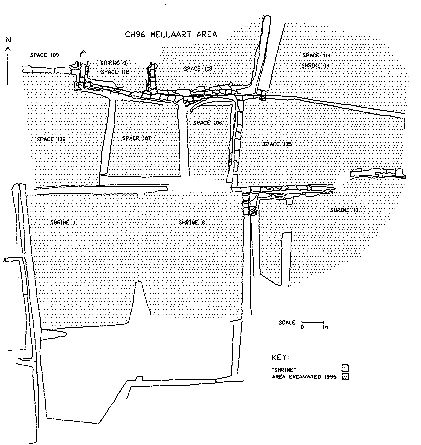The Mellaart area
The aim of excavation in this area (see below) is to go down in a 20m by 20m area in order to reach the lowest levels of the mound sampled by Mellaart in the 1960s and reported to contain Epipalaeolithic and PPNA-type obsidian. Blocked entrances were discovered between Spaces 107 and 108, and a small opening between 106 and 107. In cleaning the west wall of Shrine 14 again a large blocked entrance was observed, and another blocking was seen in the south wall of Shrine 8. All this suggests that at least at these lower levels, roof entry was not the sole means of access. Also in these lower levels (VII and VIII) many of the walls appear to have bricks made in situ on the walls (as in the pise construction at Asikli Höyük). There was evidence of much recutting of walls in complex sequences. Most of the Level VII walls in this area lay on or had been cut into Level VIII midden, sometimes with a clay fill beneath them. There was also evidence of deposition of large bones and clay balls beneath walls prior to their construction. Other walls did not fit into the Level VII, Level VIII sequence. Under the midden in Space 105 was found a building with walls containing much white marl. The fill of the two rooms in this building is very homogeneous and would appear to be several metres in depth. The walls so far uncovered are plastered but there is not as yet evidence of painting. A small eastern room in this building contains a large bin. Cleaning began in House 7 (Space 113), where two deposits of obsidian blades were found by the hearth near the south wall. This is a pattern also found in Building 1 and in the 1960s excavations.
